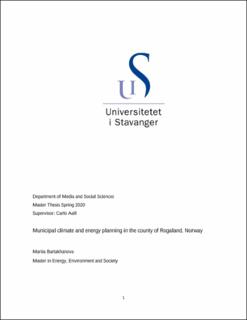| dc.contributor.advisor | Aall, Carlo | |
| dc.contributor.author | Bartakhanova, Mariia | |
| dc.coverage.spatial | Norway | en_US |
| dc.date.accessioned | 2020-10-08T09:13:33Z | |
| dc.date.available | 2020-10-08T09:13:33Z | |
| dc.date.issued | 2020-08-30 | |
| dc.identifier.uri | https://hdl.handle.net/11250/2681700 | |
| dc.description | Master's thesis in Energy, Environment and Society | en_US |
| dc.description.abstract | The aim of this master thesis is to provide an overview of climate and energy planning in all municipalities of Rogaland, Norway. Along with that it maps out barriers in work with emissions reduction that municipalities themselves report on. The research question is posed the following way: What are the outcomes of local climate policy planning in regard to greenhouse gas emissions reduction?
In order to answer this question and describe the situation with municipal work on emissions reduction we look at four main themes. First the thesis reviews municipal climate and energy plans by describing what status they have and what climate targets they commit to. Municipal plans that address emissions reduction issue also need to be followed by plans of action. Therefore, the next theme the thesis covers is municipal action plans. Here we provide information on whether municipalities have such plans at all, whether the plans get timely updated and what they contain. But in order to reduce emissions municipalities have to implement relevant climate measures and instruments. Third, the thesis provides an overview of municipal budget processes, which implies how climate measures are getting included into budgets and financial plans. Fourth, we look at how municipalities report on work with emissions reduction and implementation of such measures.
The research showed that municipalities apply a variety of approaches to work with emissions reduction. Climate plans differ in levels of detail and ambitiousness. Almost forty percent of Rogaland’s municipalities apply 1st generation climate plans that were politically adopted eight to ten years ago. Three municipalities do not have relevant action plans, and the majority of existing planes are not getting revised as often as they must. Contents of action plans also vary, as some of the state’s requirements appear to be difficult to fulfill. Municipalities in general, include climate measures and instruments into their financial plans, but almost half of the municipalities did not establish any reporting routines regarding work with emissions reduction. Altogether this research’s findings point at lack of institutionalization of emissions reduction work on a municipal level. | en_US |
| dc.language.iso | eng | en_US |
| dc.publisher | University of Stavanger, Norway | en_US |
| dc.relation.ispartofseries | Masteroppgave/UIS-SV-IMS/2020; | |
| dc.rights | Navngivelse 4.0 Internasjonal | * |
| dc.rights.uri | http://creativecommons.org/licenses/by/4.0/deed.no | * |
| dc.subject | climate planning | en_US |
| dc.subject | emissions reduction | en_US |
| dc.subject | municipal planning | en_US |
| dc.subject | climate targets | en_US |
| dc.subject | climate change | en_US |
| dc.subject | klimaplanlegging | en_US |
| dc.subject | klimamål | en_US |
| dc.subject | kommunal planlegging | en_US |
| dc.title | Municipal climate and energy planning in the county of Rogaland, Norway | en_US |
| dc.type | Master thesis | en_US |
| dc.subject.nsi | VDP::Samfunnsvitenskap: 200 | en_US |

